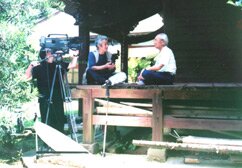![]()
JAPANESE DEVILS
The perpetrators of wartime atrocities in China tell their stories, in a new documentary film
by Linda Hoaglund
Minoru Matsui was already an experienced filmmaker when he met the former first lieutenant in Japan's Imperial Army who became the inspiration for the documentary Japanese Devils. Matsui had started his career in the 1970s, apprenticing with the esteemed feature film director Kaneto Shindo. Throughout the 1980s and 1990s, as Matsui directed numerous socially relevant television documentaries and dramas, he was always on the alert for potential documentary subjects. In 1992, he followed up a newspaper article about a veteran of Japan's war against China who publicly testified to the atrocities he had committed there.
|
Though Matsui had some knowledge of Japan's war crimes in China, he was shocked by the calm and open manner in which former First Lieutenant Kojima related his gruesome acts as a soldier in Japan's Imperial Army in China.
Kojima told Matsui about Chukiren, a unique organization he belonged to, created in 1957 to promote peace and friendship between Japan and China. Though Chukiren, translates as "returnees from China," it was created by a very specific group of approximately 1,100 veterans from the war that Japan waged against China between 1931 and |
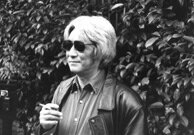 |
|
Japanese Devils director Minoru Matsui
|
In 1992, when Kojima told Matsui that many of the three hundred surviving Chukiren returnees would be willing to tell their own, similar stories, Matsui committed himself to revealing their memories in a documentary. Perhaps Matsui had a personal reason to record their stories. Though his films consistently betray an inherent skepticism of authority, he had never found the courage to ask his own father, an Imperial Army veteran who served in China, the very question he needed to ask these men: "What did you do in the war?" A question rarely asked and rarely answered in postwar Japan. Matsui approached Japanese television stations for funding, but producerswho either saw no point in dredging up the past or regarded the material as too controversialrepeatedly spurned him. Matsui temporarily abandoned the project.
He was jolted back into action when he learned of Kojima's death as reported in the Chukiren newsletter in 1998. Realizing that many of the elderly members of Chukiren would soon pass away, he turned to an old friend, Ken'ichi Oguri. Oguri had also started his film career as an assistant director in the 1970s, but had turned to making documentaries for television as the Japanese film studios spiraled into decline. Oguri recognized that Matsui had stumbled on a historic opportunity to record these veterans' testimonies and agreed to serve as producer and cameraman on the film. Using their own funds, the two friends began filming Japanese Devils in 1999.
Matsui began contacting individuals from a list of three hundred Chukiren members, searching for the broadest possible range of rank and experience, from privates to officers, military
|
|
police, and military doctors. He always began with a letter outlining the importance of the veterans' accounts as part of the true historical record of the twentieth century, underscoring his conviction that it was time the Japanese public finally heard stories describing Japanese military behavior in China, stories few had dared to tell and fewer wanted to hear. Though Chukiren members had testified in public before, this was the first time their stories would be recorded on camera, despite whatever recriminations their families might face. Japanese Devils opens with an interview with Yoshio Tsuchiya, a former second lieutenant |
|
Minoru Matsui interviewing Yoshio Shinozuka, one of the fourteen Imperial Army veterans who tell their stories in Japanese Devils
|
|
We were the poorest family in our village then. I figured I'd go to Manchuria, find work on the railroad, maybe. There was no work back then, not in Japan. Figured I'd go to Manchuria, make something of myself.
|
|
Japanese hostilities in China began in 1931, and a year later, Japan occupied Manchuria, annexing it as Manchuko, a puppet state. In 1933, Tsuchiya became an MP in the Japanese army, charged with eradicating local resistance. He remained an MP until Japan's defeat in 1945. Referring to his official duties, Tsuchiya continues,
Tsuchiya is painfully articulate on the justifications his fellow |
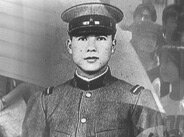 |
|
|
The young Yoshio Tsuchiya, Second Lieutenant, MP |
||
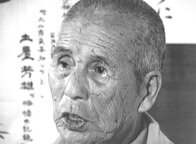 |
||
|
Yoshio Tsuchiya, now deceased, at the time of the filming
|
| We called 'em "Chinks," you know, didn't treat 'em like humans. We didn't think of "Chinks" as human, they were subhuman. If we thought they were human, we couldn't have been so cruel. If we thought they were living people . . . We thought they were scum. We did those cruel things imagining they weren't human. We also believed the emperor was a direct descendant of God. And that our orders were from that emperor. So in that war, we felt free to do anything because of Imperial orders. |
Though the Japanese had been ruthless in suppressing any perceived Chinese resistance since 1931, they began specifically targeting Chinese civilians in 1937, with the infamous massacre of civilians in Nanjing. Under the unforgiving hierarchy of Japan's Imperial Army, soldiers regarded superior orders as expressions of imperial will. The system obliterated any sense of individual conscience or responsibility, molding obedient men who followed orders blindly. New recruits quickly learned to see Chinese civilians as less than human; murder, torture, medical experimentation, and vivisection were routine in their military training. They became numb to the act of taking Chinese lives.
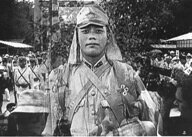 |
Yoshio Suzuki, a retired farmer now eighty-two, a former sergeant major in the army, recalls his military training:
In 1940, the Communist Eighth Route Army intensified its resistance, launching a campaign against Japanese positions and supply lines. Japan soon retaliated with a Three-Alls campaign that decimated villages: Kill All, Burn All, Loot All. Japanese soldiers savagely raped countless Chinese women, then murdered them along with children and old people, burning their homes to the ground. Masayo Enomoto, whose still ruthless stare belies his eighty-three years, also served as a sergeant major: |
|
|
Army Sergeant Major Yoshio Suzuki in uniform |
||
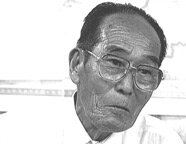 |
||
| Eighty-two-year-old Yoshio Suzuki |
| We raided a village, but all we found were the abandoned women. There was nobody else there. Because we'd found those women, and there were lots of soldiers, all of our buddies, we made the womenwe stripped them naked and made them lie down on top of watermelons. That's right. There was no military purpose, just "Imperial Army Comfort." No enemies around, no information to be gained. So we stripped 'em and shoved cloth up their vaginas, poured gasoline on them and set them on fire. And, of course, all of our company commanders watched. They weren't spies or anything. Just a message that we'd been in that village. |
As Matsui traveled around Japan, interviewing veterans, he asked them to limit their recollections to acts in which they had personally participated. Aware that the film would be explosively controversial in Japan, Matsui ruled out any use of hearsay. (Incredibly, several atrocities are even corroborated by gruesome photographs.) When U.S. design exempted the emperor from wartime culpability at the war tribunals in 1947, with China declared the new enemy of the "Free World," individual soldiers lost any incentive to speak of their individual crimes in China. In Japan, discussion of Japan's war atrocities became an explicit taboo.
After its crushing defeat in the Battle of Midway in 1942, Japan faced acute shortages of labor and raw materials. Her troops in China were ordered to seize Chinese peasants and confiscate their grain, all for export home. Postwar Japanese statistics show that nearly forty thousand Chinese were conscripted to hard labor in Japan. Thousands perished. As the tide of the war increasingly turned against Japan, her soldiers grew desperate. Sent out on month-long missions with two days' rations, soldiers scavenged everything they could; some were even reduced to eating the flesh of murdered Chinese.
On August 7, 1945, Soviet forces launched a massive attack into Manchuko. After Japan's unconditional surrender on August 15, some 575,000 Japanese troops were interned in Siberia, where they worked at hard labor in gulags. By 1950, more than 530,000 had been repatriated to Japan. In July of that year, the Soviets sent 969 of the Japanese soldiers still held in Siberia to the newly formed People's Republic as anti-Chinese war criminals. They were confined by the War Criminals Administration in Liaoning Province. In addition, 140 Japanese soldiers who had joined the Nationalist Army after Japan's defeat were confined under the Shanxi War Criminals Administration. All fourteen witnesses in this film were among those detained in China after the Soviets handed them over to Mao's newly formed Communist state.
According to the film, the war criminals were treated humanely under Zhou Enlai's motto, "Even war criminals are human. Respect their humanity." The film's narration goes on to say,
| war criminals, who had expected severe punishment, were both profoundly moved and remorseful. Their treatment eventually awakened their own consciences. They acknowledged their crimes during the occupation and apologized to the Chinese people. |
In 1956, the Supreme Court of the People's Republic of China convened a Special Military Tribunal, which indicted only forty-five Japanese, sentencing them to between eight and twenty years, including previous time served. The other Japanese prisoners were immediately repatriated to Japan.
When those thousand or so men got home, they were profoundly out of step with their rapidly modernizing country. They met with suspicion and hostility. They were frequently regarded as products of Communist brainwashing. Although most went on to marry and create families, few were able to find a place in Japanese public life, and many retreated to remote regions to eke out livings as farmers. When some followed their Chinese instructors' admonitions to speak out about what they had done, they were shunned. Speaking to young people wanting to learn about the war, veteran Suzuki explains: "Nobody back here had a clue that the Imperial Army was killing civilians over there. They all believed we'd been off fighting a just war. That we'd faced the enemy, been lucky to live and come home. That's all." After they returned, most of the men kept in touch with each other through Chukiren. A few published accounts of their crimes in China in the Chukiren newsletter or testified to community peace groups.
When the film was finished, in late 2000, Matsui and Oguri held several screenings in Japan, but attendance was poor and media coverage nonexistent. In 2001, Japanese Devils was invited to the Berlin Film Festival, to be included in the International Forum of New Cinema, celebrated for its challenging and edgy selections from around the world. Following its inclusion in the Berlin festival, Japanese Devils drew international attention, finally attracting a Tokyo theater owner who agreed to sponsor its theatrical release. Most of Japan's mainstream journalists, however, and even liberal film critics, found excuses not to attend press screenings. Preliminary audiences were largely composed of old men, many of whom had likely experienced the war. But as the weeks wore on, the theater began to fill with curious young people, many of them students, who simply wanted to learn more about this chapter in their country's history. The film completed a three-month run in Tokyo with a cumulative attendance of more than ten thousand. This unexpected success prompted more active media coverage for successive releases in Nagoya, Osaka, Kyoto, and Fukuoka, as well as locally organized screenings around the country.
Internationally, the film has been featured at many prestigious film festivals and has received a number of awards. Since premiering in Berlin, it has been screened at the Toronto Film Festival, the Hong Kong International Film Festival, and the Sarajevo Film Festival, and at documentary film festivals in Munich, New York, Amsterdam, and Troia, Portugal. Packed screenings at the San Francisco International Asian American Film Festival in March 2002 revealed just how powerfully audiences outside Japan can be affected by this film. An obviously emotional Chinese woman in the audience rose after the film to speak of how her grandmother had seen her brother stabbed to death by Japanese soldiers on the eve of his wedding. Never quite the same after that, her grandmother had raised her to hate all Japanese. She spoke of the heavy burden this hatred had become, especially after emigrating to the United States, where she began to meet friendly Japanese. Breaking down several times, she spoke of how she wished her grandmother had been able to see this film, as it finally allowed her to see Japanese as human beings like herself.
In making the film, Matsui did not intend to single out individual war criminals. Rather, by reflecting the widest range of experience possible, he sought to reveal
| . . . the true face of history, of human behavior. Before they went off to war, the men who testify to their brutal acts in this film were once very ordinary people. They were me and they were you. In order to protect the future, we must learn what really happened in that war, about the madness and weakness of the people who were cogs in the machinery that implemented that war. |
Since the film's release last December, two of the witnesses have died. Matsui now realizes that he made Japanese Devils just in time.
During World War I, the percentage of civilian casualties was fifteen percent. The figure catapulted to sixty-five percent in World War II, and now, in more recent "low-intensity" conflicts, it has risen to ninety percent. Increasingly, in twentieth-century warfare, from Nanjing, London, Dresden, and Nagasaki, to Guatemala, Bosnia, Rwanda, and the Middle East, civilians are the target.
The fourteen veterans who testify in Japanese Devils were all enlisted soldiers in Japan's Imperial Army. Half a century later, it is easy for us to condemn them. Their actions were monstrous, unfathomable. And yet they mirror the actions of other soldiers enlisted in other armies in the many twentieth-century wars against civilians.
Linda Hoaglund was born in Kyoto, the daughter of American missionary parents, and raised and educated in rural Japan. A graduate of Yale University, she has worked as an assistant director and producer for Japanese television programs and currently works with Japanese film directors and artists, translating and subtitling.
Japanese Devils is available, exclusively for educational purposes, in both a full-length version and a one-hour version, for classroom use. For further information, see www.japanesedevils.com.
